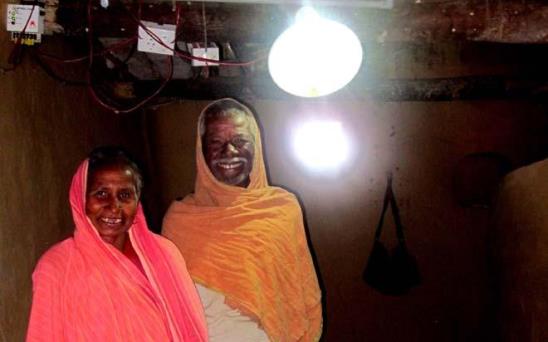Even as the government continues its physical crackdown against Naxals, a parallel effort is going on to resurrect stalled development infrastructure in the affected village areas and give a push to improved life conditions for people suffering for years at the hands of left wing extremists.
In a small but significant victory, a village named Chintalnar in the worst affected Sukma district was provided electricity after a long gap of 15 years. The move has provided cheers and delight amongst the villagers who exclaimed “we would now be able to use fridge, TV and let children study at night”.
The Maoists, in their mindless tirade against development, had destroyed the power infrastructure in Chintalnar in the year 2003 and had also warned the villagers from getting it repaired. As a result, the poor village folks had to survive without the basic facility for so long.
“Our jawans had sacrificed their lives for this (electrification) and now it is our responsibility to provide them (the villagers) with all the facilities. By June 2018, we will provide electricity to every village,” chief minister Raman Singh told journalists.
In April 2010, Chintalnar village, located about 80 kilometres from the district headquarters of Sukma, came into the spotlight when during one of the deadliest attacks on security personnel; Maoist rebels had killed 74 members of the Central Reserve Police Force (CRPF) and two policemen from Chhattisgarh police while they were on an area domination exercise near the village.
Since last year, infrastructure work including road, communication and electricity picked up pace in this region after security forces launched an offensive against Maoist rebels. The electrification of villages is in line with the Narendra Modi government’s ambitious plan to provide electricity to every village in every corner of India by March 2019.
In Chhattisgarh, the government led by chief minister Raman Singh is working hard to ensure that every village in the state gets power supply by June 2018. The State Government is attaching highest priority to power sector and is committed to provide full support to all utilities for ensuring quality power supply. Notably, Chhattisgarh was expected to add 14,140 MW of additional power generation capacity in its thermal plants from November 2015 to March 2022, according to the Central Electricity Authority (CEA).
Work has now been completed in Chintalnar village, which had been a strong foothold of the Maoists, and it is now slowly getting back on to the path of development. The villages in Naxal affected areas and other such inaccessible regions are being expeditiously connected with off-grid power solutions.
In February this year, Chhattisgarh’s Bhalupani village in Balrampur finally got electricity connection for the first time after the district administration installed solar panels for every family. Being a Naxal prone area, the initiatives taken by the government had failed to reach the village, as a result, the residents had to spend their lives in darkness for a very long time. As the dominance of Naxals from the area has vanished, the village is finally availing the benefits of the schemes of the government.
The government had announced that as many as 140 remote villages and hamlets in the Naxals-affected areas of Chhattisgarh, which have no electricity supply even 70 years after the country’s independence, will very soon be illuminated with solar power. The villages, mostly located in the dense forests of Bastar and Sarguja divisions, are getting solar power through a project being executed by Chhattisgarh State Renewable Energy Development Agency (CREDA) under the Remote Village Electrification Programme.
Earlier on 29th March, fifty-nine Naxals, including sixteen women, surrendered and laid down their arms before the police and the CRPF in Sukma. Fourteen others had been nabbed in Sukma by the security forces a day earlier. Three Naxals had separately surrendered before the Indo-Tibetan Border Police (ITBP) in Kondagaon in Chhattisgarh while five Naxals surrendered before the police in Maharashtra’s Gadchiroli.
The back to back successes for the government and the security forces can be attributed to the revamped strategy put in place by the Modi government and the Home Ministry. According to statistics, the area affected by Naxalism is shrinking rapidly. Officials attribute this success to the massive counteroffensive launched by the government against the Naxal radicals. This strategy involves targeting top level commanders and their informers. There has also been stress on precise and accurate intelligence for targeting Naxals.
Simultaneously, the local governments have also sped up the developmental process. This is manifested by increased pace of road construction, installation of mobile towers and setting up of police stations in isolated areas. Naxals are now unable to move as smoothly in the Naxal affected belt or transfer their ammunition and finances.
The Chhattisgarh government has undertaken several initiatives including the sanction of Rs 11,725 project for the construction of 5,412 km road in the Maoist-hit areas.
It has launched skill development programs, set up Navodaya and Kendriya Vidyalayas, banks, ATMs and post offices in all 35 worst affected districts.
According to the Home ministry, the flagship NHRM programme is executed by the Ministry of Health and Family Welfare in the area on a constant basis and a super speciality hospital has been approved recently at Jagdalpur by way of up-gradation of the Jadgalpur Medical College.
Mr Raman Singh has emphasized that Naxalism can only be countered through development and that there would be “no dearth of money” in this regard as long as Prime Minister Narendra Modi and Home Minister Rajnath Singh were at the helm of affairs.
“Wherever we are constructing roads and working on other areas of development, the Maoists are losing their foothold. Now, we have reached very close and are moving ahead in an important direction to root out the menace.” The Chief Minister said his government was getting better cooperation from the centre in this matter, especially after the BJP came to power in 2014, and they were working in close coordination.
